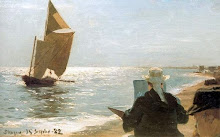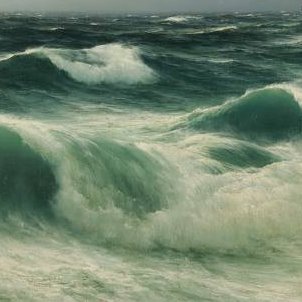Painting a moving target, like the sea, is not easy. Some seascape artists like to work from photographs. Personally, I find that, while a camera may capture the detail of that elusive veil of spray, once I look at photos back at home, hours or days later, the inspirational feeling of the moment has been lost. I find it difficult to work from photos, but they are useful as a reference, combined with sketches. Rapid sketches done on location, can be a good way of preparing for an oil seascape. With subjects as transient as a waves and spray, you have to get used to drawing or painting from memory to quite an extent.
This watercolour sketch, looks as if it has been done very quickly yet it captures all the essential elements of the scene/event. With quick sketches, there's no time to get lost in photographic detail. The artist has started with a rapid pencil sketch, drawing as lightly as possible in order to free up the subsequent washes of transparent colour.
For on site seascape studies, pencils and watercolours and a small pad of watercolour paper are more convenient to carry around than canvases and tubes of oil paint. Oil sketch paper can be substituted for bulky canvases. Small tubes, designed to minimise the weight of a plein air paint box, are available in certain brands. Some plein air oil painters, who know in advance the kind of colours they are going to encounter, take a palette with oil colours already squeezed out onto it (presumably covered to stop it drying out) leaving the heavy tubes behind. Some artists even premix the colours they expect to use, but the disadvantage of using premixed colours is that the colours in the environment are always changing. Still, something to consider.
This watercolour sketch, looks as if it has been done very quickly yet it captures all the essential elements of the scene/event. With quick sketches, there's no time to get lost in photographic detail. The artist has started with a rapid pencil sketch, drawing as lightly as possible in order to free up the subsequent washes of transparent colour.
For on site seascape studies, pencils and watercolours and a small pad of watercolour paper are more convenient to carry around than canvases and tubes of oil paint. Oil sketch paper can be substituted for bulky canvases. Small tubes, designed to minimise the weight of a plein air paint box, are available in certain brands. Some plein air oil painters, who know in advance the kind of colours they are going to encounter, take a palette with oil colours already squeezed out onto it (presumably covered to stop it drying out) leaving the heavy tubes behind. Some artists even premix the colours they expect to use, but the disadvantage of using premixed colours is that the colours in the environment are always changing. Still, something to consider.


































No comments:
Post a Comment